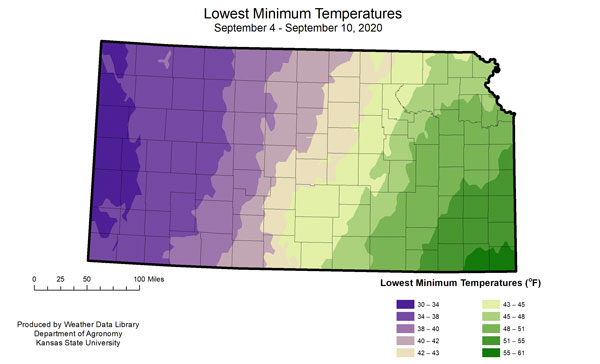Extreme low temperatures were recorded in western Kansas this week (Figure 1). For all summer crops, these killing temperatures will end development. At this point, corn is near maturity and the potential impacts of lower temperatures will have little or no impact on expected corn yields (depending on the absolute value, the duration of the stress, and phenology of the crop). The main challenges will be for soybeans in the coming weeks during the final reproductive stage, with the potential of impacting final seed weight (either affecting the rate of accumulation of dry matter on the seeds or by interrupting this process) where temperatures dropped below 32 degrees F.

Figure 1. Lowest Minimum Temperatures for week ending 10-Sep-2020 (Kansas Mesonet).
Sorghum
Wet conditions delayed sorghum planting in some areas of the state thus delaying heading. During August, cooler-than-normal temperatures dominated the state, followed by a warmer-than-normal September. A delay in flowering time could jeopardize yields if the crop is exposed to heat around blooming or if low temperatures occur during grain fill. The long-season growing-degree-day (GDD) accumulation from September 1 – October 10 portrays a lower GDD accumulation for the north central and eastern parts of the state (Figure 2). The largest departure of GDD accumulation was recorded in the south central, southeastern, and northeast-north central portions of the state (Figure 3).

Figure 2. Accumulated Long Season Sorghum Growing Degree Days.
Low temperatures will reduce seed growth and affect final test weight and seed quality. Temperatures below 40 degrees F will inhibit growth. A freeze will kill sorghum if the stalks are frozen, impairing the flow of assimilates and nutrients to the grain. A freeze at the hard-dough stage (before grain matures) will produce lower weight and chaffy seeds.
The likelihood of sorghum maturing before a freeze is related to the following factors (as affected by weather and hybrid):
- planting date,
- plant growth rate during the season, and
- date of half-bloom.
When the crop flowers in late August or early September, it may not reach maturity before the first fall freeze in some parts of the state. For the northwest, western, and north central areas, any sorghum that has not reached maturity will not.
Corn
Temperatures below 32 degrees F can produce equivalent or greater damage even when the exposure time is relatively short. Clear skies, low humidity, and calm wind conditions increase freeze damage even with temperatures above 32 degrees F. Any freeze damage at this point in the season will hardly produce any visible symptoms, but can affect the final test weight and potentially seed quality - depending on the growth stage. Corn is not affected by freeze once it reaches the black layer stage.
Soybeans
Temperatures below 32 degrees can interrupt grain filling and impact yield, meaning lower test weight and seed quality. Necrosis of the leaf canopy is a visible symptom of freeze damage. Absolute temperature is more important than the duration of the cold stress – especially if temperatures drop below 28 degrees F. As the crop approaches maturity, the impact of a freeze event on yields declines.
Ignacio Ciampitti, Cropping Systems Specialist
ciampitti@ksu.edu
Mary Knapp, Weather Data Library
mknapp@ksu.edu